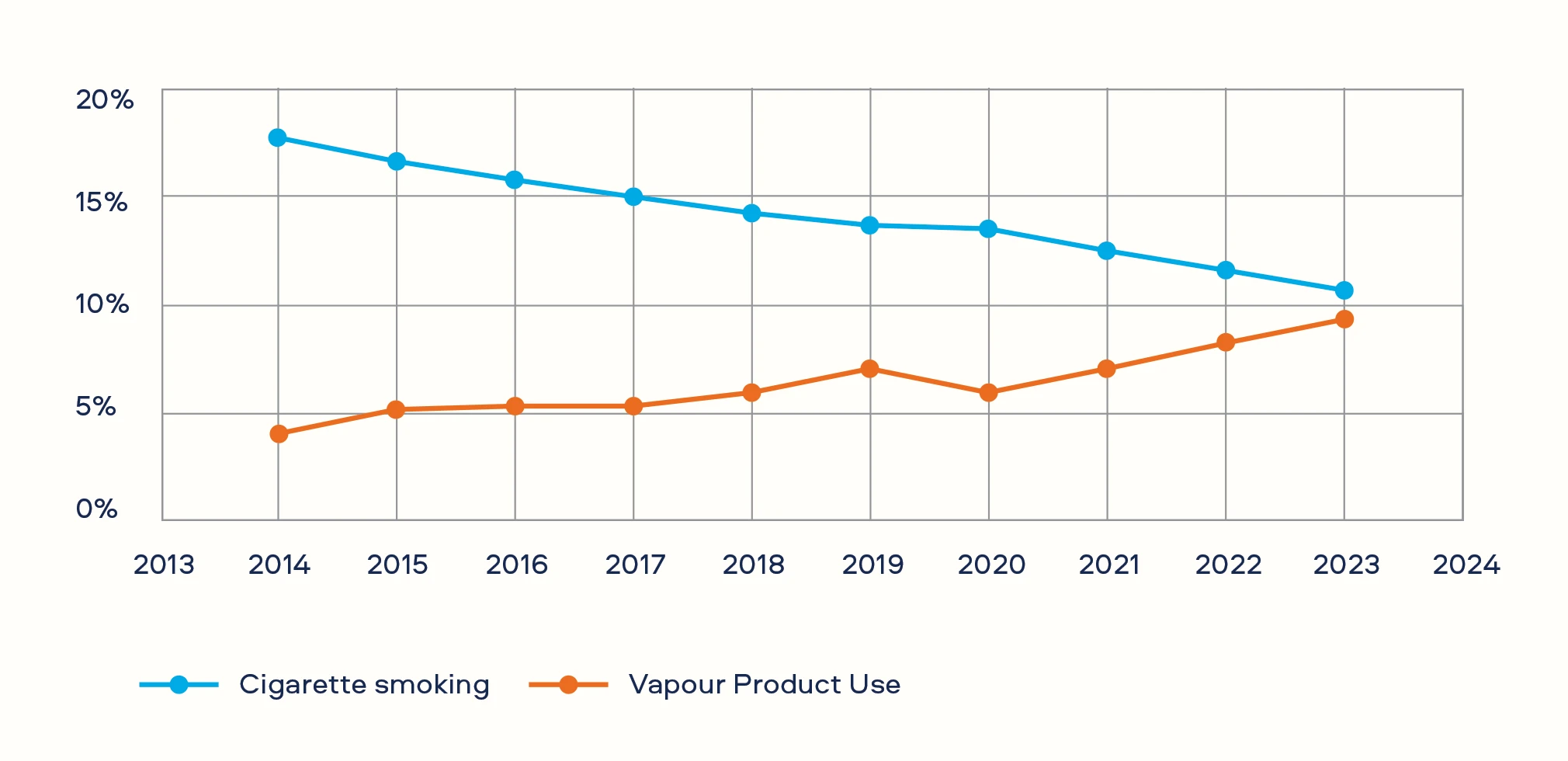UK: A Case Study
At a glance
-6.2%
Adult smoking prevalence in the UK declined by 6.2% between 2014 and 2023,[14] while adult vaping rates increased from 4.2% to 9.1%[13]
53%
53% of current vapers are ex-smokers who have switched completely to vaping[13]
2030
The UK Government has set a target to become smoke-free by 2030[6]

Sign up for more exclusive the Omni™ content
The UK Government was an early adopter in recognising the positive public health role of vaping products. Along with public health organisations, it has created an environment that has resulted in millions of smokers switching to vaping, contributing to increased reductions in smoking prevalence.
UK Government Approach
England’s public health agency, Public Health England (PHE)* first advocated for a potential role of electronic cigarettes in Tobacco Harm Reduction (THR) in 2015. That year, it published a landmark report stating that “best estimates show e-cigarettes are 95% less harmful to your health than normal cigarettes.”[1] Notably, one of the report’s authors, Professor Ann McNeill from King's College London, described e-cigarettes as a "game-changer" in public health.[2]
PHE, and its subsequent replacement in 2021, the Office for Health Improvement and Disparities (OHID), have since published eight independent reports on vaping.[3] This collection aims to provide information and guidance on e-cigarettes and vaping to inform policies and regulations. The 2022 OHID-commissioned review,[4] the most comprehensive to date, highlights that while vaping is not risk-free, it is estimated to pose only a “small fraction of the risks of smoking.”
The independent Khan Review,[5] commissioned by the UK Government to outline recommendations for achieving a smoke-free England by 2030,[6] also recommended offering vaping as a substitute for smoking, alongside accurate information on the benefits of switching, including to healthcare professionals.
Strong Advocacy from Public Health Organisations
Other UK Government agencies and health organisations, beyond OHID, have been strong advocates for vaping as a tool for THR. These include:
- The Medicines and Healthcare products Regulatory Agency (MHRA),
- The National Institute for Health and Care Excellence (NICE);[7] and
- The Action on Smoking and Health (ASH).
For example, ASH states that: “Using a nicotine vape is much less harmful than smoking in the short and medium term. However, vapes are not risk-free and their long-term health impact is unknown – though they are likely to be far less harmful than smoking.”[8]
In a 2024 evidence review, the Royal College of Physicians (RCP) reaffirmed its support for e-cigarettes as a THR tool, stating that the evidence in this area has become much stronger. RCP also emphasises the importance of preventing youth uptake while ensuring access for adult smokers who use vaping as an alternative to continued smoking.[9]
"Using a nicotine vape is much less harmful than smoking in the short and medium term. However, vapes are not risk-free and their long-term health impact is unknown – though they are likely to be far less harmful than smoking."
ASH
Action on Smoking and Health[8]
NHS Approach to Vaping
While BAT’s vapour products are neither licensed nor marketed as smoking cessation aids, strong independent public health advocacy of vaping as a tool for THR has been instrumental in shaping the NHS’s approach to vaping, leading to the inclusion of e-cigarettes in its smoking cessation guidance[10] and NHS Stop Smoking Services.[11] Following Khan’s review recommendations, in April 2023 the Department of Health and Social Care (DHSC) also announced a “Swap to Stop” programme, offering a vaping starter kit alongside behavioural support to one million smokers across England.[12]
Positive Outcomes
The positive attitude towards the role of vaping to encourage smokers to switch to reduced risk profile products in the UK has likely contributed to the increasing decline in smoking rates. Long-term data shows that as vaping has increased, smoking prevalence has contemporaneously declined as well. Between 2014 and 2023, adult vaping rates rose from 4.2% to 9.1%,[13] while smoking rates among adults decreased by 6.2%, from 18.1% to 11.9%.[14] Crucially, more than half of current vapers (53%) are ex-smokers who have switched completely to vaping.[13]
The UK’s progressive approach to tobacco harm reduction to date contrasts with the more cautious stance in a number of EU countries. As a result, the UK is one of the countries leading the transition away from smoking to Smokeless Products. In 2023, nearly a quarter (24%) of EU responders to a Eurobarometer survey conducted for the European Commission, reported that they currently smoke, with only 3% of the population using e-cigarettes.[15] Meanwhile, the smoking rate in the UK for a similar demographic was significantly lower, at 10.5%.

Tobacco and Vapes Bill
The UK Government has tasked the Department of Health & Social Care with making the country smoke-free by 2030.[6] According to the Office for National Statistics (ONS), around six million adults continued to smoke in the UK in 2023.[14] We believe that to achieve the smoke-free goal, the UK must reinforce its commitment to Smokeless Products and continue emphasising the potential of vaping to contribute to THR.
In 2024, the UK Government introduced the Tobacco and Vapes Bill to Parliament,[16] empowering the government to regulate the flavours, packaging and the display of all vapes and other nicotine products.[17] It further included a ban on advertising and sponsorship of vapes and other consumer nicotine products, like nicotine pouches.
BAT welcomed aspects of the Bill aimed at reducing underage vaping. We fully supported the proposal to ban flavours and flavour descriptors that particularly appeal to the underaged. However, it is essential to strike the right balance, protecting the underaged from vaping, while ensuring that vapour products remain accessible to adult smokers. We therefore did not support a ban on Smokeless Product advertising, as we believe adult smokers
should be made aware of such smokeless alternatives along with accurate information to make informed choices. Additionally, we have advocated for strict enforcement to prevent illegal vapour products from entering the market, including pre-market testing of all vapour products. We also supported the introduction of a mandatory nicotine 20mg cap on nicotine pouches.
Figure 1. Smoking Prevelance[14] and Vapour Product Use[13] Among UK Adults (18+)

*Replaced by the Office for Health Improvement and Disparities (OHID) in 2021
Sources:
[1] McNeill A., et al., E-cigarettes: an evidence update. Public Health England, 2015. (Accessed: 14 July 2025)
[3] Office of Health Improvement and Disparities (OHID), E-cigarettes and vaping: policy, regulation and guidance. Gov. UK, 2022. (Accessed: 21 March 2025).
[4] Office of Health Improvement and Disparities (OHID), Nicotine vaping in England: 2022 evidence update main findings. Gov. UK, 2022. (Accessed: 21 March 2025).
[5] Office for Health Improvement and Disparities (OHID), The Khan review: making smoking obsolete. Gov. UK, 2022. (Accessed: 21 March 2025)
[6] Balogun, B. and Harker, R., The smokefree 2030 ambition for England. House of Commons Library, 2023. (Accessed: 21 March 2025)
[7] National Institute for Health and Care Excellence (NICE), Tobacco: preventing uptake, promoting quitting and treating dependence (NG209). 2021. (Accessed: 21 March 2025).
[8] Action on Smoking and Health (ASH), Vaping: what you need to know. (Accessed: 06 August 2025)
[9] Royal College of Physicians, E-cigarettes and harm reduction: An evidence review. RCP, 2024. (Accessed: 21 March 25).
[10] U.K. National Health Service (NHS), Vaping to quit smoking. (Accessed: 21 March 25).
[11] U.K. National Health Service (NHS), NHS stop smoking services help you quit. (Accessed: 21 March 2025).
[12] Department of Health and Social Care, Press release: “Smokers urged to swap cigarettes for vapes in world first scheme”.Gov. UK, 2023. (Accessed: 21 March 2025).
[13] Action on Smoking and Health (ASH), Use of vapes (e-cigarettes) among adults in Great Britain. 2024. (Accessed: 21 March 2025).
[14] Office for National Statistics (ONS), Adult smoking habits in the UK: 2023. (Accessed: 21 March 2025).
[15] Eurobarometer, Attitudes of Europeans towards tobacco and related products. European Commission, 2023. (Accessed: 14 July 2025).
[16] UK Parliament, Tobacco and Vapes Bill. (Accessed: 14 July 2025).
[17] Department of Health and Social Care (OHID), Tobacco and Vapes Bill: creating a smoke-free UK and tackling youth vaping factsheet. Gov. UK. 2024. (Accessed: 14 July 2025).
Sign up for more exclusive the Omni™ content
-
 Smokeless Products: An IntroductionRead more
Smokeless Products: An IntroductionRead more -
 01. Our Vision: A Need for ReappraisalRead more
01. Our Vision: A Need for ReappraisalRead more -
 02. The Big QuestionsRead more
02. The Big QuestionsRead more -
 03. Impact of SmokingRead more
03. Impact of SmokingRead more -
 04. Our Smokeless ScienceRead more
04. Our Smokeless ScienceRead more -
 05. Our Smokeless ProductsRead more
05. Our Smokeless ProductsRead more -
 06. THR: A Global TransformationRead more
06. THR: A Global TransformationRead more -
 07. THR: Global RegulationRead more
07. THR: Global RegulationRead more -
 08. THR: Scientific EngagementRead more
08. THR: Scientific EngagementRead more -
 09. Our Future OutlookRead more
09. Our Future OutlookRead more -
 10. ReferencesRead more
10. ReferencesRead more -
 11. Our Published THR ScienceRead more
11. Our Published THR ScienceRead more
